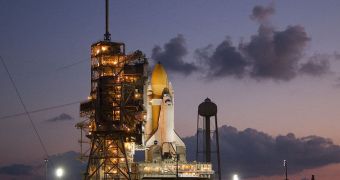After NASA engineering team struggled to fix a leak they found on space shuttle Discovery about a week ago, a new glitch is forcing mission controllers at the agency to delay the orbiter's final flight by at least a day.
Experts at the Kennedy Space Center (KSC), the home of the space shuttles, say that a new leak has been discovered aboard the spacecraft, which means that its launch will be delayed until at least November 2.
Originally, the STS-133 mission was supposed to begin this Monday, November 1, from Launch Pad 39A at the NASA spaceport. The exact time when the orbiter will take off is currently unknown.
Mission experts say that engineering teams are currently working around the clock for fixing the malfunction, so that the shuttle could launch in the days its launch window for the International Space Station (ISS) remains opened.
One of the spacecraft's twin aft-mounted engine pods sprung two leaks, in the helium and nitrogen seals that are used to apply pressure to internal fuel lines critical for a maneuvering system pod.
According to officials at NASA, quoted by Space, the new malfunctions are not related in any way to the leaks that were found and repaired on Discovery last week.
“The leaks must be fixed before launch and the decision was made to delay picking up the launch countdown by at least a day,” spokespersons from the agency said in a statement.
At this point, the provisional launch date is set for 4:14 pm EDT (2014 GMT) on Tuesday, November 2, just 2 days ahead of the planned flyby of the EPOXI spacecraft around Comet Hartley 2.
Six astronauts will fly on the STS-133 mission, which will spend about 11 days attached to the ISS. NASA astronaut Steve Lindsey will be the commander for this flight.
Eric Boe will be Discovery's final pilot, while astronauts Alvin Drew, Tim Kopra, Michael Barratt and Nicole Stott will be the mission specialists.
All of them are veterans of the American space program, and all have been to the ISS at least once before, either as commanders, or ISS flight engineers.
Their new assignment is to deliver a Permanent Multipurpose Module (PMM) to the station, and then affix it in its proper place during an extra-vehicular activity (EVA).
Two spacewalks are prepared for the STS-133, during which time the Discovery astronauts will handle maintenance work outside of the ISS.
The STS-133 crew will also deliver Robonaut-2 to the ISS. This is the first human-like robot to make its way to low-Earth orbit. It was developed by experts at NASA and General Motors.
The machine is very strong, and yet capable to handling various tools like a human. It was designed to assist astronauts in cumbersome tasks inside and outside the ISS.

 14 DAY TRIAL //
14 DAY TRIAL //